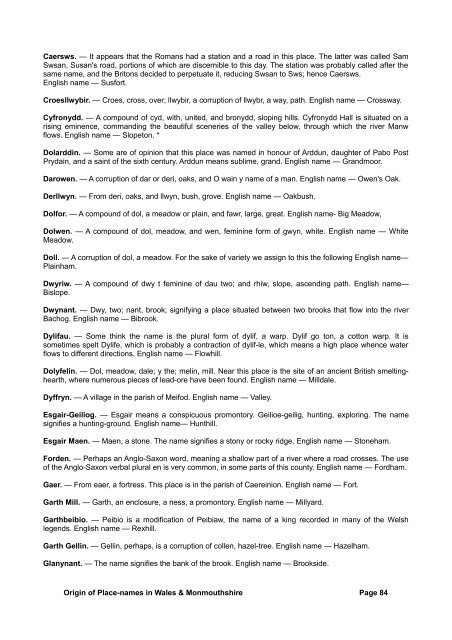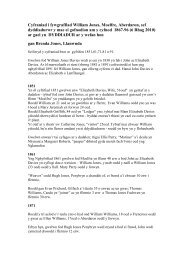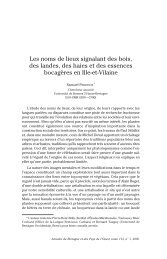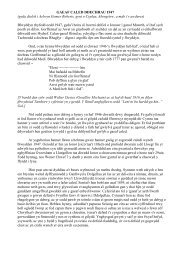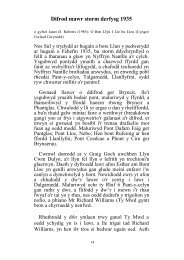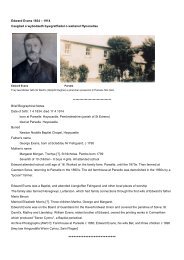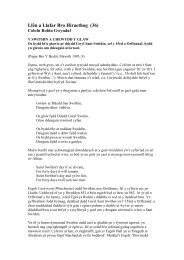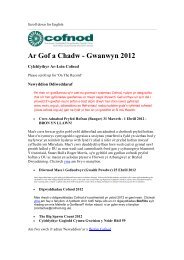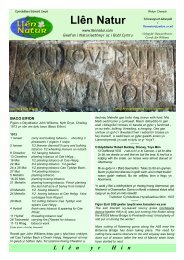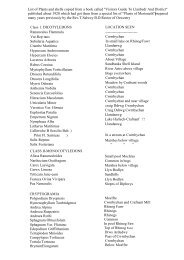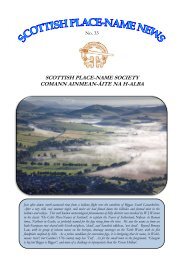to Exeter; <strong>the</strong> Ax to Axbridge; <strong>and</strong> <strong>the</strong> Ux jo<strong>in</strong>s <strong>the</strong> Thames near Oxford. We have an Esk <strong>in</strong> Donegal; anEsky <strong>in</strong> Sligo; <strong>and</strong> a Wisk <strong>in</strong> Yorkshire. The Gaelic <strong>and</strong> Erse word for water is uisge, <strong>of</strong> which whiskey isprobably a corruption. English name — Waterton.Victoria. — The <strong>place</strong> was anciently called Troed-rhiw'r-clawdd, which signifies a <strong>place</strong> near a dyke at <strong>the</strong>foot <strong>of</strong> <strong>the</strong> hill. The present name is derived from <strong>the</strong> street that leads to <strong>the</strong> <strong>place</strong> from Ebbw Vale.Waun Avon. — A compound <strong>of</strong> waun, meadow, moor; <strong>and</strong> afon, river, from its proximity to <strong>the</strong> source <strong>of</strong> <strong>the</strong>river Llwyd. English name — Rivermoor.MONTGOMERYSHIRE.The Welsh name is Trefaldwyn, Baldw<strong>in</strong>'s town, so called <strong>in</strong> honour <strong>of</strong> Baldw<strong>in</strong>, a Norman general, who builta castle on <strong>the</strong> border <strong>of</strong> <strong>the</strong> county. In 1090, <strong>the</strong> castle was taken by Roger Montgomery, <strong>and</strong> <strong>the</strong> Saxonscalled <strong>the</strong> <strong>place</strong> afterwards Montgomery. Some seem to th<strong>in</strong>k <strong>the</strong> English name is a Norman corruption <strong>of</strong>Mynyddy Cymry, <strong>the</strong> mount <strong>of</strong> <strong>the</strong> Kymry.Aberhavesp. — The <strong>place</strong> is situate at <strong>the</strong> confluence <strong>of</strong> <strong>the</strong> rivers Havesp <strong>and</strong> Severn; hence <strong>the</strong> nameHavesp signifies a river whose channel is dry <strong>in</strong> <strong>the</strong> summer. English name— Hespmouth.Aberrhosan. — Abet, estuary; rhosan, <strong>the</strong> name <strong>of</strong> <strong>the</strong> river, which signifies <strong>the</strong> meadow brook. Englishname— Moorbrook.Abermule. — The village is situated near <strong>the</strong> po<strong>in</strong>t where <strong>the</strong> river Mule discharges itself <strong>in</strong>to <strong>the</strong> Severn.Mule is probably a contraction <strong>of</strong> mudliw, chang<strong>in</strong>g colour, from which we have <strong>the</strong> English motley, Englishname — Motleyton.Blarnglesyrch. — A <strong>place</strong> situate on <strong>the</strong> rivulet Ghsyrch, from which it takes its name. Glesyrch is acorruption <strong>of</strong> glas-erch, dusky blue. English name- Dusky ham.Butt<strong>in</strong>gton. — The Welsh name is Talybont, x bridgend, from a bridge cross<strong>in</strong>g <strong>the</strong> Severn nearby.Offa'sDyke passes through <strong>the</strong> parish, <strong>and</strong> here-abouts, separates Engl<strong>and</strong> from Wales. Dur<strong>in</strong>g <strong>the</strong> Saxon periodit was called Butdig<strong>in</strong>gtune; hence Butt<strong>in</strong>gton. The name signifies Archer's town.Bwlchyffridd. — Bwlch, pass, breach; y, <strong>the</strong>; ffridd, plantation, forest. English name — Passwood.Carno. — From cam, cairn, heap. Pennant says: " The mounta<strong>in</strong>s <strong>of</strong> Carno, like those <strong>of</strong> Gilboa, arecelebrated for <strong>the</strong> fall <strong>of</strong> <strong>the</strong> mighty. On a mounta<strong>in</strong> called Mynydd y Garn or Garnedd, a huge heap <strong>of</strong> stoneswas raised to commemorate <strong>the</strong> death <strong>of</strong> a celebrated warrior. English name — Moundham.Cann Office. — An abbreviation <strong>of</strong> Cannon Office, so called from <strong>the</strong> cannons used by Cromwell's soldiersdur<strong>in</strong>g <strong>the</strong>ir encampment <strong>in</strong> <strong>the</strong> <strong>place</strong>.Ceri. — A corruption <strong>of</strong> Caerau, fortresses or walls, accord<strong>in</strong>g to some; but some derive it from Cm HirLyngwyv, <strong>the</strong> name <strong>of</strong> Caradog's gr<strong>and</strong>fa<strong>the</strong>r, who was <strong>the</strong> owner <strong>of</strong> <strong>the</strong> estate, which, as it was customary<strong>the</strong>n, was called after his name. O<strong>the</strong>rs derive it from ceri, <strong>the</strong> medlar tree, which, it is supposed, abounded<strong>in</strong> <strong>the</strong> district <strong>in</strong> time <strong>of</strong> yore. We adopt <strong>the</strong> latter derivation. English name — Medlarton.Cemmaes. — A compound <strong>of</strong> cefn, back, ridge, <strong>and</strong> maes, a field. English name — Highfield.Clitterwood. — Perhaps from glitter <strong>and</strong> wood.Crigion. — A corruption <strong>of</strong> crugiau, heaps. English name— Heapham.Church Stoke. — From stoc, or stocce, <strong>the</strong> stem or ma<strong>in</strong> part <strong>of</strong> a tree. Woodstock, woody <strong>place</strong>.Cyfeiliog. — This pleasant vale is named <strong>in</strong> honour <strong>of</strong> Owen Cyfeiliog, who, <strong>in</strong> 1130, became <strong>the</strong> sole owner<strong>of</strong> <strong>the</strong> estate through <strong>the</strong> death <strong>of</strong> his gr<strong>and</strong>fa<strong>the</strong>r, Meredyth, <strong>the</strong> pr<strong>in</strong>ce. The name, means "compacttoge<strong>the</strong>r." English name — Jo<strong>in</strong>ton.Orig<strong>in</strong> <strong>of</strong> Place-<strong>names</strong> <strong>in</strong> Wales & Monmouthshire Page 83
Caersws. — It appears that <strong>the</strong> Romans had a station <strong>and</strong> a road <strong>in</strong> this <strong>place</strong>. The latter was called SamSwsan, Susan's road, portions <strong>of</strong> which are discernible to this day. The station was probably called after <strong>the</strong>same name, <strong>and</strong> <strong>the</strong> Britons decided to perpetuate it, reduc<strong>in</strong>g Swsan to Sws; hence Caersws.English name — Susfort.Croesllwybir. — Croes, cross, over; llwybir, a corruption <strong>of</strong> llwybr, a way, path. English name — Crossway.Cyfronydd. — A compound <strong>of</strong> cyd, with, united, <strong>and</strong> bronydd, slop<strong>in</strong>g hills. Cyfronydd Hall is situated on aris<strong>in</strong>g em<strong>in</strong>ence, comm<strong>and</strong><strong>in</strong>g <strong>the</strong> beautiful sceneries <strong>of</strong> <strong>the</strong> valley below, through which <strong>the</strong> river Manwflows. English name — Slopeton. *Dolardd<strong>in</strong>. — Some are <strong>of</strong> op<strong>in</strong>ion that this <strong>place</strong> was named <strong>in</strong> honour <strong>of</strong> Arddun, daughter <strong>of</strong> Pabo PostPryda<strong>in</strong>, <strong>and</strong> a sa<strong>in</strong>t <strong>of</strong> <strong>the</strong> sixth century. Arddun means sublime, gr<strong>and</strong>. English name — Gr<strong>and</strong>moor.Darowen. — A corruption <strong>of</strong> dar or deri, oaks, <strong>and</strong> O wa<strong>in</strong> y name <strong>of</strong> a man. English name — Owen's Oak.Derllwyn. — From deri, oaks, <strong>and</strong> llwyn, bush, grove. English name — Oakbush.Dolfor. — A compound <strong>of</strong> dol, a meadow or pla<strong>in</strong>, <strong>and</strong> fawr, large, great. English name- Big Meadow,Dolwen. — A compound <strong>of</strong> dol, meadow, <strong>and</strong> wen, fem<strong>in</strong><strong>in</strong>e form <strong>of</strong> gwyn, white. English name — WhiteMeadow.Doll. — A corruption <strong>of</strong> dol, a meadow. For <strong>the</strong> sake <strong>of</strong> variety we assign to this <strong>the</strong> follow<strong>in</strong>g English name—Pla<strong>in</strong>ham.Dwyriw. — A compound <strong>of</strong> dwy t fem<strong>in</strong><strong>in</strong>e <strong>of</strong> dau two; <strong>and</strong> rhiw, slope, ascend<strong>in</strong>g path. English name—Bislope.Dwynant. — Dwy, two; nant, brook; signify<strong>in</strong>g a <strong>place</strong> situated between two brooks that flow <strong>in</strong>to <strong>the</strong> riverBachog. English name — Bibrook.Dylifau. — Some th<strong>in</strong>k <strong>the</strong> name is <strong>the</strong> plural form <strong>of</strong> dylif, a warp. Dylif go ton, a cotton warp. It issometimes spelt Dylife, which is probably a contraction <strong>of</strong> dylif-le, which means a high <strong>place</strong> whence waterflows to different directions. English name — Flowhill.Dolyfel<strong>in</strong>. — Dol, meadow, dale; y <strong>the</strong>; mel<strong>in</strong>, mill. Near this <strong>place</strong> is <strong>the</strong> site <strong>of</strong> an ancient British smelt<strong>in</strong>ghearth,where numerous pieces <strong>of</strong> lead-ore have been found. English name — Milldale.Dyffryn. — A village <strong>in</strong> <strong>the</strong> parish <strong>of</strong> Meifod. English name — Valley.Esgair-Geiliog. — Esgair means a conspicuous promontory. Geilioe-geilig, hunt<strong>in</strong>g, explor<strong>in</strong>g. The <strong>names</strong>ignifies a hunt<strong>in</strong>g-ground. English name— Hunthill.Esgair Maen. — Maen, a stone. The name signifies a stony or rocky ridge. English name — Stoneham.Forden. — Perhaps an Anglo-Saxon word, mean<strong>in</strong>g a shallow part <strong>of</strong> a river where a road crosses. The use<strong>of</strong> <strong>the</strong> Anglo-Saxon verbal plural en is very common, <strong>in</strong> some parts <strong>of</strong> this county. English name — Fordham.Gaer. — From eaer, a fortress. This <strong>place</strong> is <strong>in</strong> <strong>the</strong> parish <strong>of</strong> Caere<strong>in</strong>ion. English name — Fort.Garth Mill. — Garth, an enclosure, a ness, a promontory. English name — Millyard.Garthbeibio. — Peibio is a modification <strong>of</strong> Peibiaw, <strong>the</strong> name <strong>of</strong> a k<strong>in</strong>g recorded <strong>in</strong> many <strong>of</strong> <strong>the</strong> Welshlegends. English name — Rexhill.Garth Gell<strong>in</strong>. — Gell<strong>in</strong>, perhaps, is a corruption <strong>of</strong> collen, hazel-tree. English name — Hazelham.Glanynant. — The name signifies <strong>the</strong> bank <strong>of</strong> <strong>the</strong> brook. English name — Brookside.Orig<strong>in</strong> <strong>of</strong> Place-<strong>names</strong> <strong>in</strong> Wales & Monmouthshire Page 84
- Page 1 and 2:
HANDBOOK OF THE ORIGIN OF PLACE-NAM
- Page 3 and 4:
§ § § § §The Author begs to st
- Page 5 and 6:
pitiful cries of the railway offici
- Page 7 and 8:
Bishop Percy says that "in England,
- Page 9 and 10:
The city of Chester is still popula
- Page 11 and 12:
There's Cumwhitton, Cumwhinton, Cum
- Page 13 and 14:
Llwyn in its primary' sense means a
- Page 15 and 16:
PLACE-NAMES IN WALES.Wales. — The
- Page 17 and 18:
Church are generally dedicated to e
- Page 19 and 20:
think he was a contemporary of St.
- Page 21 and 22:
Rhosbeirio. — Rhos, a moor, a dry
- Page 23 and 24:
of Brecknock," states that this vic
- Page 25 and 26:
Cam cnwir ef Cwmdu,Cwm gwyn yw & n
- Page 27 and 28:
Penderyn. — A corruption probably
- Page 29 and 30:
Ardudwy. — Ar, upon or above; tud
- Page 31 and 32:
to mark its pre-eminence over the o
- Page 33 and 34:
Some think that eirw is a corruptio
- Page 35 and 36: present form — Caerfyrddin.Abergw
- Page 37 and 38: place of refuge; hence the name. En
- Page 39 and 40: Llansawyl. — The church was dedic
- Page 41 and 42: eject. The village took its name fr
- Page 43 and 44: house, and attempted to kill an inf
- Page 45 and 46: Gwydir. — Prima facie one may tak
- Page 47 and 48: Nefyn. — The church was probably
- Page 49 and 50: DENBIGHSHIRE.Anglicized form of Din
- Page 51 and 52: Llangollen. — From Collen, a sain
- Page 53 and 54: hands into their pockets to pay a c
- Page 55 and 56: Cefn. — The name signifies a ridg
- Page 57 and 58: Maesgarmon. — Named in honour of
- Page 59 and 60: Abertridwr. — Tridwr, three water
- Page 61 and 62: it is said, was originally built by
- Page 63 and 64: Cwmllynfell. — Cwm, a narrow vale
- Page 65 and 66: Gwarycaeau. — Gwdr, the nape of t
- Page 67 and 68: means a cultivated region, a vale,
- Page 69 and 70: Penrhiwfer.- Pen, head, top; rhiw,
- Page 71 and 72: Port Talbot. — So called in 1835
- Page 73 and 74: Trealaw. — This appellation was g
- Page 75 and 76: Aberdyfi. — So called from its si
- Page 77 and 78: Llanddwywe. — From Dwywau, a desc
- Page 79 and 80: Crickhowell and some in the directi
- Page 81 and 82: Griffithstown. — This village was
- Page 83 and 84: and gwy, water. Treiddiod troth tna
- Page 85: derive Tintern from din, fortified
- Page 89 and 90: English name — Ervylton.Llanymech
- Page 91 and 92: Angle. — Probably from the angle-
- Page 93 and 94: Gellyswick. — Another hybrid. Gel
- Page 95 and 96: that the two rivers in their flowin
- Page 97 and 98: ecame the bishop of the see, and wa
- Page 99 and 100: earth formerly stood on a summit on
- Page 101 and 102: Pilleth. — A corruption of pwll,
- Page 103 and 104: Howells, Rev. J., Mountain AshHowel
- Page 105 and 106: Williams, D., PenywernWilliams, Rev


